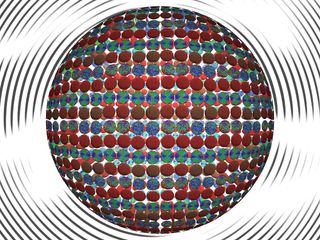Using Liquid Crystals as Scaffolding

This Research in Action article was provided to LiveScience in partnership with the National Science Foundation.
Displayed for artistic purposes on the surface of a sphere, each circle in the image above presents a unique result from a computer simulation that reveals the structure of specialized nanodroplets.
The nanodroplets are filled with liquid crystals and covered with surfactant molecules (green) and water molecules (red). (Surfactants are molecules that lower the surface tensions of liquids, such as detergents and dispersants.)
The different patterns represent the different ways that the surfactants can self-organize — based on such factors as temperature and molecule concentrations — as they interact with the liquid crystals.
Liquid crystals consist of elongated, rod-like molecules that can pack efficiently in a liquid and assume a uniform orientation. Different orientations can "bend" light in different manners, giving rise to a palette of colors and textures that are used in a myriad of applications.
Not surprisingly, liquid crystals have gradually earned a prominent place in everyday life. They are, for example, widely used in modern display technologies, ranging from computer screens to giant TV displays. Such displays rely on changes to the orientation of liquid crystal molecules; different colors and pixels in the display correspond to different orientations of the liquid crystals.
Previous research has shown that manipulating material surfaces can influence the orientation of liquid crystals. Recently, researchers at the University of Wisconsin-Madison discovered that the opposite is also true. A liquid crystal can in fact imprint its morphology onto a surface and influence the way molecules on that surface line up.
Sign up for the Live Science daily newsletter now
Get the world’s most fascinating discoveries delivered straight to your inbox.
Reporting on the May 3, 2012, issue of the journal Nature, the group led by Juan de Pablo revealed that it's possible to use liquid crystals as scaffolding to build novel materials with undiscovered properties.
The researchers used molecular simulations of liquid crystals encapsulated in tiny nanoscopic droplets to show that molecules located at the droplet surface can adopt intricate, previously unknown nanoscale patterns.
When the droplets are hot, the liquid crystals are disordered and surface molecules are homogeneously distributed. When the droplets are cooled, the liquid crystal becomes ordered and, in doing so, the molecules on the surface forced to also become ordered — thereby translating information from the inside of the droplet to the exterior world.
The newly discovered liquid-crystal-mediated nanopatterns could have applications in a variety of technologies, including fabrication of advanced materials with new and useful optical, mechanical and electrical properties.
This research was part of a partnership with the Materials Research Science and Engineering Center at the University of Wisconsin. Read more about the discovery in the University of Wisconsin's press release and in NSF's news teaser.
Editor's Note: Any opinions, findings, and conclusions or recommendations expressed in this material are those of the author and do not necessarily reflect the views of the National Science Foundation. See the Research in Action archive.
Most Popular



